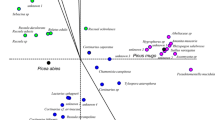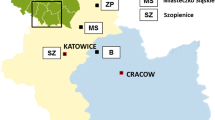Abstract
Ectomycorrhizae are symbiotic relationships between soil fungi and higher plants. Evidence of the symbiosis is the presence of a ‘mantle,’ a hyphal layer that covers root tips, and a change in root morphology. The potential use of ectomycorrhizal mantles as hydrology indicators for wetland determinations was evaluated on the Delmarva Coastal Plain (Delaware and eastern shores of Maryland and Virginia, USA) over three seasons. In theory, the distribution of mantles with soil depth should vary from uplands to wetlands in most years, as mantle development is considered to be impeded by anaerobic conditions. At four forested locations, plots were set up in seasonally-saturated wetlands and adjacent uplands and drained wetlands (twelve sub-sites). Plots were evaluated according to the Corps of Engineers Wetlands Delineation Manual for soils, plant community, and hydrology to identify a jurisdictional classification. Hydrology was further addressed using automated monitoring wells (twice daily readings), and anaerobic conditions were confirmed via platinum electrodes. Plant roots (Pinus taeda was targeted) were sampled via spade slices in March and August each year and separated by depth: O horizon, 0–5 cm, 5–10 cm, 10–15 cm, and 15–20 cm. Roots were evaluated for the presence of mantles. A threshold depth of 5 cm was identified. From a total of 892 roots with mantles in uplands (including effectively-drained wetland sub-sites), 253 (28%) were found below the threshold depth. For wetlands (including one ineffectively-drained wetland), seven of 331 roots with mantles (2%) were found below the threshold depth. Temporal and spatial variability in mantle data was common; however, mantles consistently occurred at greater depths where seasonally high water tables were lower. We concluded that mantle depth has potential as a hydrology indicator.
Similar content being viewed by others
Literature cited
Bentivengea, S. P. and B. A. Hetrick. 1992. The effect of prairie management practices on mycorrhizal spores. Mycologia 84:522–527.
D’Angelo, E. M. and K. R. Reddy. 1994. Diagenesis of organic matter in wetlands receiving hypereutrophic lake water: I. Distribution of dissolved nutrients in soil and water columns. Journal of Environmental Quality 23:928–936.
Environmental Laboratory. 1987. Corps of Engineers wetlands delineation manual. US Army Engineer Waterways Experiment Station. Vicksburg, MS, USA. Technical Report Y-87-1.
Fogel, R. 1980. Mycorrhizae and nutrient cycling in natural forest ecosystems. New Phytologist 86:199–212.
Kahn, A. G. and M. Belik. 1995. Occurrence and ecological significance of mycorrhizal symbiosis in aquatic plants. p. 627–668. In A. Varma and B. Hock (ed.) Mycorrhiza: Structure, Function, Molecular Biology, and Biotechnology. Springer-Verlag. New York, NY, USA.
Lakhanpal, T. N. 2000. Ectomycorrhiza-an overview. p. 101–118. In K. G. Mukerji, B. P. Chamola, and J. Singh (ed.) Mycorrhizal Biology. Kluwer Academic/Plenum Publishers. New York, NY, USA.
Litell, R. C., G. A. Milliken, W. W. Stroup, and R. D. Wolfinger. 1996. SAS® System for Mixed Models, SAS Institute Inc., Cary, NC, USA.
Lodge, D. J. 1989. The influence of soil moisture and flooding on formation of VA-endo and ectomycorrhizae in Populus and Salix. Plant Soil 117:243–253.
Lodge, D. J. and T. R. Wentworth. 1990. Negative associations among VA-mycorrhizal fungi and some ecto-mycorrhizal fungi inhabitating the same root system. Oikos 57:347–356.
Marks, G. C. and R. C. Foster. 1973. Structure, morphogenesis, and ultrastructure of ectomycorrhizae. p. 1–41. In G. C. Marks and T. T. Kozlowski (ed.) Ectomycorrhizae. Academic Press, New York, NY, USA.
Marshall, P. E. and N. Pattullo. 1981. Mycorrhizae occurrence in willows in a northern freshwater wetland. Plant Soil 59:465–471.
Mejstrik, V. 1976. Ecology of mycorrhiza in plants from peat bog areas of the Trebon Basin in relation to the ground water table. Quaest Geobiology 16:99–174.
National Technical Committee for Hydric Soils. 2003. Technical standards for hydric soils. Hydric Soils Note 11. Available online at ftp://ftp-fc.egov.usda.gov/NSSC/Hydric_Soils.pdf.
Ponnamperuma, F. N. 1972. The chemistry of submerged soils. Advances in Agronomy 24:29–95.
Reed, P. B., Jr. 1997. Revision of the national list of plant species that occur in wetlands. U.S. Department of the Interior, U.S. Fish and Wildlife Service, Washington, DC, USA.
Russell, R. S. 1977. Plant Root System. McGraw-Hill, London, England.
Slankis, V. 1973. Hormonal relationships in mycorrhizal development. p. 231–239. In G. C. Marks and T. T. Kozlowski (ed.) Ectomycorrhizae-Their Ecology and Physiology. Academic Press, New York, NY, USA.
Smith, S. E. and D. J. Read. 1997. Mycorrhizal Symbiosis. Academic Press, San Diego, CA, USA.
Stenstrom, E. and T. Unestam. 1987. Susceptibility to flooding in pine mycorrhiza development using different mycorrhizal fungi. p. 69. In Abstracts of 7th North American Conference On Mycorrhiza. May 3–8, 1987. Gainesville, FL, USA.
Straatsma, G., L. van Griensven, and J. Bruinsma. 1986. Root influence on in vitro growth of hyphae of the mycorrhizal mushroom Cantharellus cibarius replaced by carbon dioxide. Plant Physiology 67:521–528.
Trappe, J. M. 1962. Fungus associates of ectotrophic mycorrhizae. Botany Review 28:538–606.
Trappe, J. M. 1977. Selection of fungi for ectomycorrhizal inoculation in nurseries. Annual Review of Phytopathology 15:203–222.
USACOE. 1992. Clarification and interpretation of the 1987 Manual. Guidance Letter. March 6, 1992. Washington, DC, USA.
USDA, Natural Resources Conservation Service, 1998. Field indicators of hydric soils in the United States. ver. 4.0. G. W. Hurt, P. M. Whited, and R. F. Pringle (eds.) USDA-NRCS in cooperation with the National Technical Committee for Hydric Soils. Fort Worth, TX, USA.
USDA, Soil Conservation Service. 1994. National Food Security Act Manual. 3rd ed. Washington, DC, USA.
Author information
Authors and Affiliations
Rights and permissions
About this article
Cite this article
Vasilas, B., Vasilas, L., Thompson, J. et al. Ectomycorrhizal mantles as indicators of hydrology for jurisdictional wetland determinations. Wetlands 24, 784–795 (2004). https://doi.org/10.1672/0277-5212(2004)024[0784:EMAIOH]2.0.CO;2
Received:
Revised:
Accepted:
Issue Date:
DOI: https://doi.org/10.1672/0277-5212(2004)024[0784:EMAIOH]2.0.CO;2




